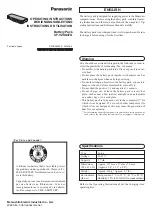
Troubleshooting Guide
5
31039B
wired correctly. If the Electronic Timer Kit
operates properly, the charger is ready for
use. Always monitor the first charge cycle to
verify that the charger is turning off properly.
SECTION 2 – CHARGER FUSE BLOWS
The charger fuse assembly consists of a dual
element fuse link under a transparent cover
mounted on the charger front panel. Each fuse
element is electrically connected in series with a
rectifier diode to provide protection for the
transformer in the event of a diode failure. Visually
inspect and electrically test the fuse to determine if
one or both fuse links are blown and refer to Part A
or Part B for test procedures.
Locate and correct
cause of trouble before replacing blown fuse.
DO NOT attempt to repair the fuse link as
inadequate protection will result.
Part A Single fuse link blows
This condition is normally caused by a short circuit
failure of one diode. The fuse link will blow when the
charger DC output connector is connected to the
battery connector, regardless of whether the power
supply cord is connected to an outlet. To check the
diodes, disconnect the power supply cord from its
outlet and the DC output connector from the battery
connector, and then disconnect one transformer
secondary coil lead from the diode terminal. Using a
low voltage continuity tester, connect one tester lead
to the diode mounting plate and the other tester lead
to a diode terminal.
Note the reading, then reverse the tester leads, and
check each diode again. If a diode conducts current
in both directions, it is "shorted" and the complete
Heatsink Assembly with Diodes must be replaced.
Part B Both fuse links blow
This is normally caused by a reverse polarity
connection between the charger DC output
connector and the battery connector. Check the
battery pack and battery connector to be sure they
are wired in the correct polarity. If possible, check
the voltage and polarity at the battery connector with
a DC voltmeter. Also, check the charger DC output
connector for the correct polarity. The WHITE or
RED wire should be connected to the positive (+)
contact, and the BLACK wire to the negative (-)
contact. If a reverse polarity connection is made
between the charger and batteries, both fuse links
will blow regardless of whether the power supply
cord is connected to an outlet.
SECTION 3 – AMMETER READS 30 AMPS FOR
MORE THAN 30 MINUTES
This high output condition is caused by misuse,
connecting the charger to an incorrect battery
system which is lower than what is rated for the
charger. A common error is to install one or more of
the batteries in a battery pack reverse polarity.
Using a suitable DC voltmeter, test to be sure all
batteries in a battery pack are correctly wired, and
also test the battery pack voltage at the charging
connector. After charging for 30 minutes at this
excessive rate, the measured on-charge voltage
should rise to 34 to 38 volts DC for a 36-volt system.
While charging, voltage measurements lower than
this indicate an incorrect or failed battery pack that
must be corrected before using the charger.
CAUTION: DO NOT CONNECT THE
CHARGER TO BATTERY PACKS WHICH ARE
NOT RATED FOR THE CHARGER. THIS MISUSE
WILL CAUSE OVERHEATING AND TRANS-
FORMER BURN-OUT WILL RESULT.
SECTION 4 – CHARGER OUTPUT IS LOW
The most probable cause of low output is a single
fuse link blowing as a result of a short circuit failure
of one diode. Refer to Section 2, "Charger Fuse
Blows", for troubleshooting procedures. On rare
occasions, a short circuit failure of the transformer
coils may cause the output to be low. Refer to
Section 7, "Transformer Short or Burn-out", for test
procedures.
Another failure that could cause low output is an
open diode on the heatsink assembly. To check for
an open diode, follow the procedures in “Section 2 –
CHARGER FUSE BLOWS, Part A Single fuse link
blows” and test the continuity of both diodes. An
open diode will not have continuity in either
direction.
CAUTION: DO NOT USE THE CHARGER IF
THE OUTPUT IS LOW. BATTERIES WILL NOT
REACH FULL CHARGE, THEREBY INCREASING
THE POSSIBILITY OF A HARMFUL DEEP
DISCHARGE DURING THEIR NEXT USE.
SECTION 5 – CHARGER TURN-OFF
MALFUNCTIONS
The Electronic Timer Kit turns the charger off as well
as on. Proper charge time is determined by many
factors, but the main elements are: (1) battery size,
(2) depth of battery discharge, and (3) finish charge
rate. Large, severely discharged batteries require
more time to reach full charge than do smaller,
lightly discharged batteries.
The charge rate, as indiated by current flow in
amperes on the panel meter, is controlled by the
batteries' rising voltage during charge. The higher
the on-charge voltage will rise, the lower the finish
charge will be before the Electronic Timer terminates
charging.
THE FOLLOWING TIMER MALFUNCTIONS ARE
OCCASIONALLY DUE TO FACTORS OTHER
THAN THE CHARGER'S PERFORMANCE. TO
HELP ISOLATE THE PROBLEM, IT IS OFTEN


























